Suzuki XL-7
The Suzuki XL-7 (styled as XL7 for the second generation) is a mid-size SUV sold by Suzuki from 1998 to 2009, over two generations. Slotted above the Grand Vitara in Suzuki's lineup, the XL-7 offered three-row seating.
| Suzuki XL-7 | |
|---|---|
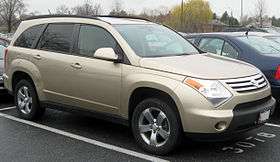 | |
| Overview | |
| Manufacturer | Suzuki (1998–2006) General Motors (2007–2009) |
| Production | 1998–2009 |
| Body and chassis | |
| Class | Mid-size SUV (1998-2006) Mid-size crossover SUV (2006-2009) |
| Layout | Front engine, rear-wheel drive (1998–2006) Transverse front-engine, front-wheel-drive (2006–2009) all-wheel-drive (1998–2009) |
| Chronology | |
| Successor | Chevrolet Captiva Chevrolet Equinox (North America) |
First generation (XL-7; 1998–2006)
| First generation | |
|---|---|
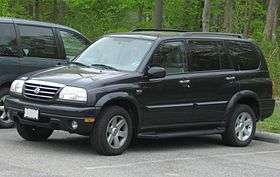 | |
| Overview | |
| Also called | Suzuki Grand Vitara XL-7 (Europe) Suzuki Grand Escudo XL-7 (Japan and Indonesia) Chevrolet Grand Vitara XL-7 |
| Production | 1998–2006 |
| Model years | 1999–2006 |
| Assembly | Japan: Hiroshima Indonesia: Bekasi (Suzuki Indonesia) |
| Body and chassis | |
| Class | Mid-size SUV |
| Layout | Front engine, rear-wheel drive / four-wheel drive |
| Related | Suzuki Escudo |
| Powertrain | |
| Engine | 2.5 L H25A V6 (Indonesia) 2.7 L H27A V6 |
| Transmission | 5-speed manual 4-speed automatic |
| Dimensions | |
| Wheelbase | 110.2 in (2,799 mm) |
| Length | 187.4 in (4,760 mm) (2002–06) 183.6 in (4,663 mm) (1998-01) |
| Width | 70.1 in (1,781 mm) |
| Height | 68.0 in (1,727 mm) 67.5 in (1,714 mm) |
The first-generation XL-7 was a Suzuki design, had a body-on-frame construction, and was essentially a stretched Grand Vitara. The North American version had a Suzuki-designed 2.5- or 2.7-liter V6 engine , on a rear-wheel drive-based platform with optional four-wheel drive. The UK version was also available with a 2.0-liter diesel engine, made by various manufacturers including Peugeot.
A unique trait in the US market in this segment, the XL-7 was available with five-speed manual transmission, in both five- and seven-seat variants.
When introduced, the XL-7 was the least expensive SUV available with three-row seating in North America. It sold over 100,000 a year in the US, and was awarded the Consumers Digest "Best Buy" award. However, sales slowed as the vehicle aged relative to the competition.
_wagon_(2010-02-24)_02.jpg) 1999–2000 Suzuki Grand Vitara XL-7 (JA; Australia)
1999–2000 Suzuki Grand Vitara XL-7 (JA; Australia)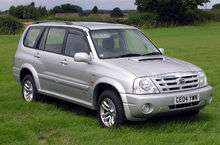 2004 Suzuki Grand Vitara XL-7 (UK)
2004 Suzuki Grand Vitara XL-7 (UK)- Suzuki Grand Escudo (Japan)
Second generation (XL7; 2006–2009)
| Second generation (Suzuki XL7) | |
|---|---|
 | |
| Overview | |
| Production | 2006–2009 |
| Model years | 2007–2009 |
| Assembly | Ingersoll, Ontario, Canada |
| Body and chassis | |
| Class | Mid-size crossover SUV |
| Layout | Transverse front-engine, front-wheel drive / all-wheel drive |
| Platform | GM Theta platform/GMT193 |
| Related | Chevrolet Equinox Pontiac Torrent Saturn Vue |
| Powertrain | |
| Engine | 3.6 L N36A V6 |
| Transmission | 5-speed manual 5-speed automatic (2007-08) 6-speed automatic (2009) |
| Dimensions | |
| Wheelbase | 112.4 in (2,855 mm) |
| Length | 197.2 in (5,009 mm) |
| Width | 72.2 in (1,834 mm) |
| Height | 68.9 in (1,750 mm) |
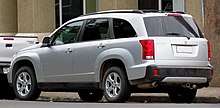
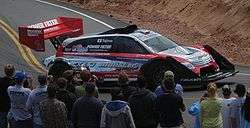
Introduced on November 22, 2006, Suzuki partnered with General Motors to build the 2007 model year version, now called XL7 (without the hyphen). It used the same unibody platform and many of the same components as the Chevrolet Equinox, Pontiac Torrent, Saturn Vue and Opel Antara but incorporated third row seating exclusive to the Suzuki. The second generation model used a version of the GM High Feature engine—designated N36A by Suzuki—built in Japan and shipped to CAMI Automotive in Ingersoll, Ontario, Canada, where the XL7 was assembled with the Equinox and Torrent. Styling cues on the 2007 model include a chrome slotted grille and trapezoidal headlights. It no longer has the spare tire mounted on the rear door.
From its introduction in 2007 until its discontinuation in 2009, the second-generation Suzuki XL7 was available in five trim levels: Base (2007-08 only), Special (2007 only), Premium (2008-2009 only), Luxury (2007-2009), and Limited (2007-2009). Depending upon the trim level selected, both two-row, five-passenger seating and XL7 specific three-row, seven-passenger seating (the related Chevrolet Equinox and Pontiac Torrent did not offer third-row seating as an option). All XL7's came decently-equipped, and depending upon the trim level selected, could be equipped with options such as a premium audio system with a subwoofer and an amplifier, faux wood interior trim, luxury leather-trimmed seating surfaces with power-adjustable and heated dual front bucket seats, remote start, a security system, chrome-clad aluminum-alloy wheels, a power sunroof, a Bluetooth hands-free phone system (2009 models only), a single-disc, CD/MP3 player audio system, a six-disc, in-dash CD/MP3 changer audio system, a touchscreen GPS navigation system with SiriusXM Nav Traffic, SiriusXM Satellite Radio, and a rear backup camera system, among other options. Unlike the related Chevrolet Equinox and Pontiac Torrent, the General Motors (GM) OnStar in-vehicle telematics system was not available on the XL7.
All second-generation XL7's were powered by the General Motors (GM) High-Feature N36A V6 producing 252 horsepower and 243 lb. ft. of torque. While 2007 and 2008 models used a five-speed automatic transmission, 2009 models received a new six-speed automatic transmission. Both Front Wheel Drive (FWD) and All Wheel Drive (AWD) models of the XL7 were available.
In May 2009, Suzuki halted production of the XL7 indefinitely due to low demand.[1] Through May 10, 2009, CAMI Automotive Inc. had only produced four XL7s for Suzuki after producing more than 12,000 units the previous year. While no direct replacement to the three-row XL7 was available (General Motors offered the larger Buick Enclave, Chevrolet Traverse, and GMC Acadia midsize three-row crossover SUV's), the Chevrolet Equinox and GMC Terrain were considered the successors to the two-row XL7. The 2009 XL7 would be the final vehicle built by General Motors (GM) in partnership with Suzuki Motors.
Markets
The second generation XL7 is also sold in Mexico, South America, the Middle East, etc.
Other versions
The XL7 nameplate is reused in Indonesia as the crossover SUV-inspired derivative of the second generation Ertiga MPV since 2020. It shares nothing but name with the previous versions of XL-7/XL7.
References
- Ross, Jeffrey N. (2009-05-13). "Suzuki Halts Production of XL7 Crossover". Autotropolis.com. Retrieved 2009-05-13.